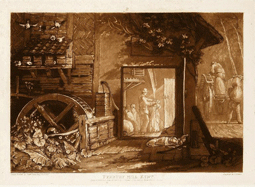Pembury Mill, Kent, from 'Liber Studiorum'
Joseph Mallord William Turner (1775-1851), engraved and published by Charles Turner (1773-1857). Mezzotint on paper, 1808
WorkRuskin found this scene of English 'every-day occurrence' (Works, 3, p. 236), 'peculiarly simple' in comparison to Turner's Alpine scenes and 'dreamy' Italian landscapes. It comes from Liber Studiorum, a set of 71 architectural and landscape pictures, etched and produced in mezzotint by Turner and his assistants between 1807 and 1819.Ruskin may have got the idea for the prints from Claude Lorrain's Liber Veritatis, or 'Studies of Truth', a set of topographical landscapes prints produced in 1635-36. 'Liber Studiorum' translates roughly as 'free studies', a title that refers to the fact that the prints were not commissioned or ordered. Turner could choose the subjects himself.The prints in Liber Studiorum come in different categories: Mountainous, Historical, Architectural, Pastoral and 'EP' (generally thought to mean Elevated or Epic Pastoral). In Turner's words, these themes were meant to 'attempt a classification of the various styles of landscape.'
ArtistJoseph Mallord William Turner was a major English landscape and history painter. As a thirteen-year old boy, Ruskin was given an illustrated second edition of Samuel Roger's poem Italy (1830), which contained twenty-five watercolour vignettes by Turner, each engraved on steel. These inspired him with life-long affection for the artist.The young Ruskin was first moved to defend Turner in print on reading a review in Blackwood's Edinburgh Magazine of three paintings hung at the Royal Academy in 1836. Juliet and her Nurse and Mercury and Argos had been singled out for criticism by the Reverend John Eagles. Collection of the Guild of St George, Museums Sheffield
Although the letter written in response was not published, the episode caused Ruskin to embark on the more extended defence of Turner's art that one finds in the first volume of Ruskin's Modern Painters. This work dwelt on Turner's 'truth to nature', which was illustrative of the dictum that 'There is a moral as well as material truth,—a truth of impression as well as of form,—of thought as well as of matter’ (Works, 3, p. 104).
Ruskin on Liber StudiorumRuskin collected prints from Liber Studiorum and placed several sets in the Collection of the Guild of St George. He encouraged people to approach the Liber Studiorum as a set, so that comparison could be made between subjects and techniques.The prints made an impression on Ruskin's artistic practice. This is noticeable in the brown sepia tones and strong ink outlines of his drawings, which seem to copy the style of the mezzotint printing method.Ruskin also studied the figures Turner depicted in his prints; the range of expression and body language of the characters fascinated him. He referred in this context to Turner's 'largeness of sympathy' (Works, 6, p. 19), a capacity for depicting emotion comparable in his view to Shakespeare's. |



















